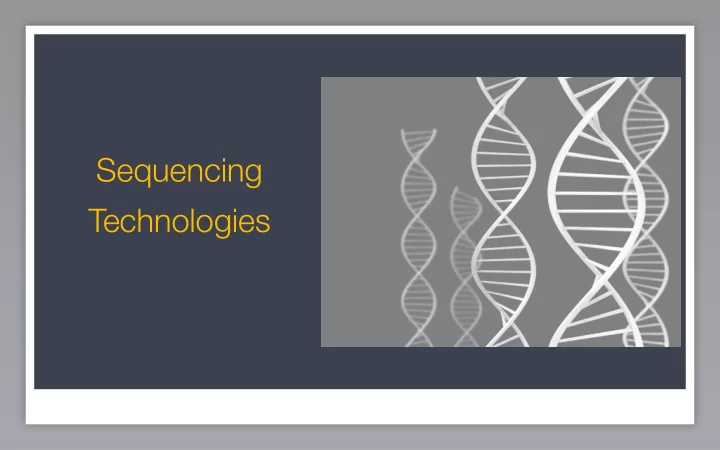

Sequencing Technologies
Benchtop Production-Scale Illumina: Sequencing Platforms https://www.illumina.com/systems/sequencing-platforms.html 2
Benchtop Benchtop Production-Scale Production-Scale
Nextseq500 HiSeq2500 HiSeq3000/4000 Illumina: flow cell https://www.illumina.com/company/news-center/multimedia-images.html
Illumina Sequencing by Synthesis How does it work? 5
Illumina 8 "Lanes" (two flow cells per HiSeq) (one-lane FC for MiSeq) Surface of flow cell is coated with a lawn of oligo pairs ... Illumina: flow cell HTS 2014-09-15 UC Davis Genome Center | Bioinformatics Core | J Fass http://training.bioinformatics.ucdavis.edu/docs/2014/09/september-2014-workshop/Monday_JF_HTS_lecture.html
Cluster Generation: Illumina Hybridize Fragments & Extend Adapter ● Millions of single Sequence (contains primer) molecules hybridize Adapter to the lawn of adapters ● dsDNA extended by polymerases HTS 2014-09-15 UC Davis Genome Center | Bioinformatics Core | J Fass Illumina: cluster generation http://training.bioinformatics.ucdavis.edu/docs/2014/09/september-2014-workshop/Monday_JF_HTS_lecture.html
Cluster Generation: Illumina Denature Double-stranded DNA Original strand ● dsDNA is denatured New strand ● Original template fragment washed away discard ● Newly synthesized Original strand Newly synthesized strand strand is covalently bound to flow cell Illumina: cluster generation HTS 2014-09-15 UC Davis Genome Center | Bioinformatics Core | J Fass http://training.bioinformatics.ucdavis.edu/docs/2014/09/september-2014-workshop/Monday_JF_HTS_lecture.html
Cluster Generation: Illumina Covalently-Bound, Randomly Dispersed Single Molecules ● Resulting covalently- bound DNA dsDNA is denatured, original DNA fragments are bound washed away. Newly synthesized strand to the flow cell surface in a random is covalently bound to flow cell. pattern UC Davis Genome Center | Bioinformatics Core | J Fass HTS 2014-09-15 Illumina: cluster generation http://training.bioinformatics.ucdavis.edu/docs/2014/09/september-2014-workshop/Monday_JF_HTS_lecture.html
Cluster Generation: Illumina Bridge Amplification ● Single-strand flops over to hybridize to adjacent adapter, forming a bridge ● dsDNA synthesized from primer in hybridized adapter HTS 2014-09-15 UC Davis Genome Center | Bioinformatics Core | J Fass Illumina: bridge amplification http://training.bioinformatics.ucdavis.edu/docs/2014/09/september-2014-workshop/Monday_JF_HTS_lecture.html
Cluster Generation: Illumina Bridge Amplification ● dsDNA bridge now formed ● each strand covalently bound to different adapter HTS 2014-09-15 UC Davis Genome Center | Bioinformatics Core | J Fass Illumina: bridge amplification http://training.bioinformatics.ucdavis.edu/docs/2014/09/september-2014-workshop/Monday_JF_HTS_lecture.html
Cluster Generation: Illumina Bridge Amplification ● dsDNA bridge is denatured Reverse strand Forward strand HTS 2014-09-15 UC Davis Genome Center | Bioinformatics Core | J Fass Illumina: bridge amplification http://training.bioinformatics.ucdavis.edu/docs/2014/09/september-2014-workshop/Monday_JF_HTS_lecture.html
Cluster Generation: Illumina Bridge Amplification ● Single strands flop over to hybridize to adjacent adapters, forming bridges ● dsDNA synthesized by polymerases HTS 2014-09-15 UC Davis Genome Center | Bioinformatics Core | J Fass Illumina: bridge amplification http://training.bioinformatics.ucdavis.edu/docs/2014/09/september-2014-workshop/Monday_JF_HTS_lecture.html
Cluster Generation: Illumina Bridge Amplification ● Bridge amplification cycles repeated many times HTS 2014-09-15 UC Davis Genome Center | Bioinformatics Core | J Fass Illumina: bridge amplification http://training.bioinformatics.ucdavis.edu/docs/2014/09/september-2014-workshop/Monday_JF_HTS_lecture.html
Cluster Generation Illumina ● dsDNA bridges denatured ● Strands in one of the orientations cleaved and washed away Illumina: cluster generation HTS 2014-09-15 UC Davis Genome Center | Bioinformatics Core | J Fass
Sequencing By Synthesis Illumina ● Sequencing primer is Sequencing primer hybridized to adapter sequence, starting Sequencing By Synthesis Illumina: Prepare for sequencing HTS 2014-09-15 UC Davis Genome Center | Bioinformatics Core | J Fass http://training.bioinformatics.ucdavis.edu/docs/2014/09/september-2014-workshop/Monday_JF_HTS_lecture.html
T C A G T C A A G T A T T T Illumina: sequencing by synthesis
Illumina: base calling http://www.slideshare.net/CRS4/chris-jones-crs4-sta ff -meeting-24032010
Number of clusters ~= Number of reads Number of sequencing cycles ~= Length of reads 19
Cluster Generation: Illumina Bridge Amplification ● Single strands flop over to hybridize to adjacent adapters, dsDNA is denatured, and 3’ ends are de- forming bridges protected. Template folds over and binds ● dsDNA synthesized second oligo on flow cell. by polymerases HTS 2014-09-15 UC Davis Genome Center | Bioinformatics Core | J Fass Illumina: paired-end sequencing http://training.bioinformatics.ucdavis.edu/docs/2014/09/september-2014-workshop/Monday_JF_HTS_lecture.html
Pacific Biosciences: http://www.pacb.com/ Oxford Nanopore (MinION): https://nanoporetech.com/ 10X Genomics: https://www.10xgenomics.com/ Other Sequencing Platforms 21
Advantages Disadvantages Pacific Iso-Seq protocol for transcripts up to High cost, large machines Biosciences 10Kb, high base calling accuracy Various kits (direct RNA, direct cDNA, Oxford High errors rate affects assembling de novo cDNA-PCR), short transcripts ( < 700bp), Nanopore transcripts, higher amount of cDNA input portable, high yield Low cost (integrated with short-read Extra preparation step (barcode), extra 10X Genomics technology), barcoding for accurate computational step isoform detection, low error rates Transcriptomics with long read technologies 22
These materials have been developed by members of the teaching team at the Harvard Chan Bioinformatics Core (HBC). These are open access materials distributed under the terms of the Creative Commons Attribution license (CC BY 4.0), which permits unrestricted use, distribution, and reproduction in any medium, provided the original author and source are credited.
Recommend
More recommend